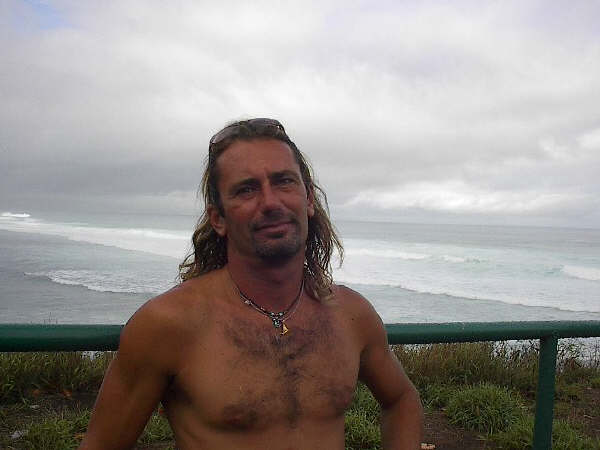I only went for a quick very early windsurfing session before the strong wind kicked in and a thousand sailors showed up and I still didn't like it. I'm spoiled and happy to be.
This guy instead must be stoked to be celebrating his 100th birthday steering the kite on a kite-catamaran. Congratulations from all the staff of MauiSurfReport! Photo by Jimmie Hepp

NW ground swell on the rise today, let's have a look at the 6am (I think! The time stamps are all screwed up on the surfline page) buoy readings:
NW
7.4ft @ 17s from 301° (WNW)
5.0ft @ 10s from 95° (E)
Waimea
3.4ft @ 9s from 27° (NNE)
2.3ft @ 20s from 311° (NW)
2.0ft @ 4s from 43° (NE)
2.0ft @ 11s from 330° (NW)
Lanai
1.9ft @ 8s from 171° (S)
Lanai
1.9ft @ 8s from 171° (S)
1.8ft @ 7s from 171° (S)
1ft @ 11s from 198° (SSW)
0.8ft @ 14s from 202° (SSW)
In the absence of the Pauwela buoy, the following analysis becomes even more important. Or... does it really?
I put three arrows on the NW buoy graph to indicate when the swell rose to 2, 4 and 6 feet. The period was 20-18s so we can expect that energy to take 12h to get to Maui. As a matter of fact, it seems it took a little less than that (like 10h) to reach Oahu, if I compare when the Waimea buoy reached 2f. But that's a wrong way of proceeding. Those 2f at the NW buoy will lose some size in those 10 hours, so probably the original 2f became 1.7 feet and hit Waimea 8-9h later. Long period energy loses less size when travelling than shorter period energy, so it becomes even more complicated to guess local sizes and arrival times when the period changes.
Fortunately it's not a question of life and death really, so we can live with some approximations.
Let's now take the last arrow I drew: it indicates that at midnight the NW buoy recorded 6f 18s.
So can I say that that energy - minus the decay from travelling - will hit Maui at around noon?
Not quite. It's gonna be that energy minus also the loss due to the refraction off the upstream islands.
Notice the direction, in fact. A very often overlooked info is the direction graph, which is right below the size and period graph. 301 is a direction that gets heavily refracted. If you don't remember, check this post where I calculated many shadowing angles. The one for Hookipa is 305.
"So how much energy will we get at noon, for god's sake?!?" I imagine someone screaming while losing his patience...
I put three arrows on the NW buoy graph to indicate when the swell rose to 2, 4 and 6 feet. The period was 20-18s so we can expect that energy to take 12h to get to Maui. As a matter of fact, it seems it took a little less than that (like 10h) to reach Oahu, if I compare when the Waimea buoy reached 2f. But that's a wrong way of proceeding. Those 2f at the NW buoy will lose some size in those 10 hours, so probably the original 2f became 1.7 feet and hit Waimea 8-9h later. Long period energy loses less size when travelling than shorter period energy, so it becomes even more complicated to guess local sizes and arrival times when the period changes.
Fortunately it's not a question of life and death really, so we can live with some approximations.
Let's now take the last arrow I drew: it indicates that at midnight the NW buoy recorded 6f 18s.
So can I say that that energy - minus the decay from travelling - will hit Maui at around noon?
Not quite. It's gonna be that energy minus also the loss due to the refraction off the upstream islands.
Notice the direction, in fact. A very often overlooked info is the direction graph, which is right below the size and period graph. 301 is a direction that gets heavily refracted. If you don't remember, check this post where I calculated many shadowing angles. The one for Hookipa is 305.
"So how much energy will we get at noon, for god's sake?!?" I imagine someone screaming while losing his patience...
Sorry, nobody can tell exactly. I'm gonna guess that the Pauwela buoy would probably read something like 5f 18s from 315 around noon, but don't forget that even if it's sitting (well, it was) only 6 miles offshore of Hookipa its shadowing angle is 299, so it will get less refraction then Hookipa let alone the coast west of Hookipa.
I hope that all this analysis has by now convinced the most that it's not worth to spend too much time into it. Going by experience and empirical observations is still of great value, and by using that, I'm gonna guess that the first inconsistent overhead sets will start showing up at Hookipa during the late morning. I could have just said that, but I hope that someone still enjoyed the discussion. If you did, I got more like that at the very end of this post.
This swell will peak Saturday morning (Butterfly Effect ladies, there will be some shore break and the even some outer reef might be breaking) at 8f 15s from 313 according to Surfline.
I hope that all this analysis has by now convinced the most that it's not worth to spend too much time into it. Going by experience and empirical observations is still of great value, and by using that, I'm gonna guess that the first inconsistent overhead sets will start showing up at Hookipa during the late morning. I could have just said that, but I hope that someone still enjoyed the discussion. If you did, I got more like that at the very end of this post.
This swell will peak Saturday morning (Butterfly Effect ladies, there will be some shore break and the even some outer reef might be breaking) at 8f 15s from 313 according to Surfline.
Definitely not much in the morning, as you would expect from the buoy readings and as the webcam shows. Not much on the south shore either (lahaina on the left looks fun).
MC2km map at noon shows some wind, but not in nuking category anymore.

Wind map shows fetches:
- the WNW just off north Japan is associated with the next storm on the conveyor belt. Related swell frocasted by Surfline to peak in the night between Wednesday and Thursday at 8f 15s from 318.
- the NNW one is what's left over from the fetch that generated today's swell.
- the windswell one

South Pacific shows yesterday's nice fetch now aiming at the Americas. We might get some angular spreading. It's hard to really know how much it will spread also because the flat graphical representation doesn't take into account the curvature of the Earth.
It should go back to a better orientation in a couple of days.

Since there might be a small ESE pulse coming, I calculate the shadowing angle from the Big Island to La Perouse: 161. I like even numbers, so I'm gonna try to remember 160. I'll add this map to the "NW buoy to Maui travelling time and shadowing angles" post which is available for future references in the labels section of this blog.

And after checking on that post, I realized that I never calculated the shadowing angle for a very popular beach: Kanaha. The angle there seems to be 319 and is due to the West Maui Mountain more than Molokai. So, a swell coming from 325 for example, shouldn't feel any influence from either one.
A swell coming from 320 will feel some influence from the WMM instead.
I've watched for years big breakers off the golf course in Waiehu in such occasions, because the reef bends the sets towards itself leaving JUST Sand Piles pretty much flat, while all the next breaks down the coast towards Kahului will have plenty waves instead.
Anything more west than that can still eventually get to Kanaha (and the Waiehu coast) depending on size and period. You can imagine Molokai doing a first part of the refraction for the swells between 310 and 320 and Kauai and Oahu doing adding more refraction from swells more west than that. In other words, good luck at trying to predict the size of the waves at Big Left on a 10f 15s swell from 305. That's when you just get in the car and go check. For sure you can expect less consistency than if it was hitting straight without refraction. That's when experience and years of empirical observations come into play. So try to reserve a few neurons of your precious set for that important task, if you care about surfing your favorite conditions. Or just relax, drink your coffee and check this blog every morning.












No comments:
Post a Comment